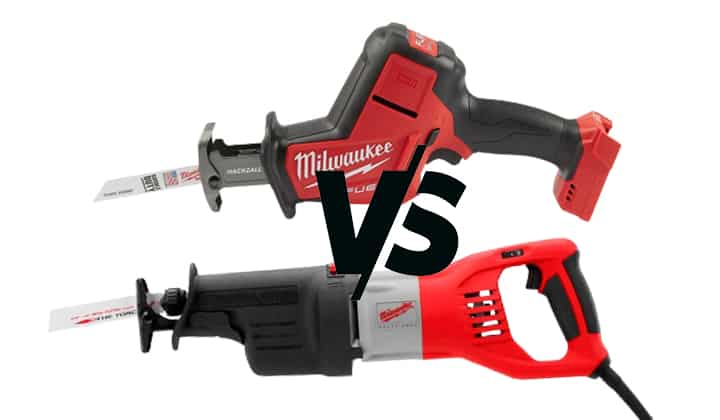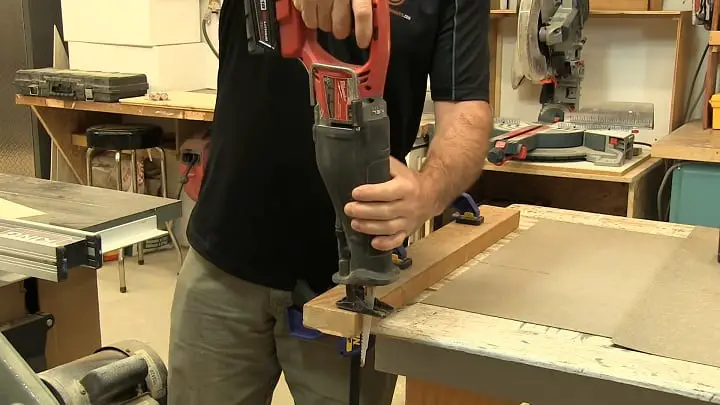Reciprocating saw is one of the popular tools used for a wide variety of crafts. But when you search or inquire about a reciprocating saw, you will find the term Sawzall most of the time. It might leave some people confused.

But many of them don’t know that Sawzall is a kind of reciprocating saw itself. So, to clearly know about the reciprocating saw vs Sawzall debate, be sure to read this article thoroughly.
In this article, we will give a distinct analysis of the differences between these saws.
In this post we'll cover:
Reciprocating Saw
A reciprocating saw is a type of machine-powered saw which utilizes a reciprocating motion of the blade. It has a blade identical to a jigsaw and a handle attached to allow it to be used comfortably on surfaces that are hard to reach with regular saws.
Sawzall Saw
On the other hand, Sawzall is one of the brands of reciprocating saw. It was invented in 1951 by a company named Milwaukee Electric Tool. It was one of the best reciprocating saws you could buy during that time. That’s why people started to call other reciprocating saws by Sawzall because of its popularity.
Common Characteristics of Reciprocating Saw and Sawzall
The unique features of a reciprocating saw and a Sawzall are mentioned below-
Design
Reciprocating saws have various models which offer different advantages with their types. Depending on how they are made, the models may differ in speed, power, and weight, from light handheld models to high power models for heavy works.
You can also get reciprocating saws specially made for specific types of works. The saw’s blade can be changed according to the surface it will be used on.
Battery
There are two types of reciprocating saws – cordless and corded reciprocating saw. The cordless one requires lithium-ion batteries while the other one requires no batteries but an electric source to plug the cord in.
Mechanism
Due to its unique mechanism, the saws have been named reciprocating saws. The reciprocating action is formed by using different types of tools inside it. A crank, scotch yoke drive, captive cam, or barrel cam may be used for the mechanism.
Generally, any saw that uses a back and forth motion for cutting is termed as a reciprocating saw. This jigsaw, saber saw, rotatory reciprocating saw, and scroll saw also fall into the category of reciprocating saws.
Uses
Regular reciprocating saws are a relatively powerful and rough tool. So, these are used for heavy-duty and demolition works most of the time. However, there are also some reciprocating saws available made explicitly for light works or crafts.
Unique Features of a Sawzall
Sawzall is the upgraded version of a simple reciprocating saw. The upgraded Sawzall has many modern features added to it for user convenience. With its new abilities, works have become faster and easier.
Unlike typical reciprocating saws, Sawzall has some notable additions that make the tool convenient and pleasant to use.
It has a forward-mount supported point which makes it easier to control. The grips are also made with rubber, so it is easy on the hands.
Apart from this, Sawzall is lighter and smaller than most other reciprocating saws, even though they contain the same power. So, Sawzall is made to be a more balanced model.
At last, its ability to change speed and blades depending on the working surface, work has been made easier than ever.
Reciprocating Saw vs Sawzall | Pros and Cons
As reciprocating saw and Sawzall are pretty much the same tools, they also have similar advantages and disadvantages.
Pros
- Reciprocating saws are available in both corded and cordless versions. The best thing is regardless of which type you choose; both are compact and portable. Because of their convenient size, these can be carried easily to any place.
- You can easily control the speed of the orbital action of the saw, which comes in handy during changing surfaces. Due to this, it can be used comfortably on most surfaces like wood, brick, walls, etc.
- If you have a cordless reciprocating saw, there is no need for an electric source to plug the saw into as it runs on batteries. That makes it easier for you to carry the saw and use it anytime and anywhere.
- One of the advantageous features of the reciprocating saw is, these are incredibly versatile. You can easily cut objects both horizontally and vertically, which generally can’t be done with other similar tools.
Cons
- You have to be careful if you want to purchase a reciprocating saw for light works, as typical reciprocating saws mainly support heavy-duty and demolition works. For light jobs, you need to look for reciprocating saws specifically made for specific types of work.
- A saw is a power tool; you can’t achieve accurate cuts on objects as these are generally used for demolition tasks.
- A Reciprocating saw consists of a highly sharp blade. It becomes even more dangerous when it is turned on. If you don’t take extreme caution before using a reciprocating saw, you may face life-threatening injuries.
- Using the corded reciprocating saw is a bit disadvantageous in some cases. There needs to be an electric source always available for the saw to work. The cord also may obstruct the word, especially in small rooms.
What Makes Sawzall Stand out Among Other Reciprocating Saws?
When the Sawzall first came out in 1951 manufactured by Milwaukee Electric Tool, it was simply a step above all other reciprocating saws. According to many users, it was the best reciprocating saw during that time.

It was so impressive that it didn’t require much time to become popular all over the world. Since then, Sawzall has been set as a basic standard for all other reciprocating saws, and people started calling all reciprocating saws Sawzall.
This indicated the superiority of Sawzall over all other reciprocating saws. That’s why, whenever your search for a reciprocating saw, the term Sawzall is bound to appear as well.
Conclusion
So, from the article, you can see that there is no general difference between these two saw options except for the fact that Sawzall had been a superior type of reciprocating saw when it was first released.
The next time someone asks for your opinion on reciprocating saw vs Sawzall, you can simply tell that all Sawzall is reciprocating saws, but not all reciprocating saws are Sawzall.
By reading this article, we hope you will have a general idea about these saws, and there won’t be any confusion.
I'm Joost Nusselder, the founder of Tools Doctor, content marketer, and dad. I love trying out new equipment, and together with my team I've been creating in-depth blog articles since 2016 to help loyal readers with tools & crafting tips.
